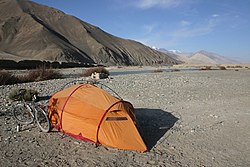geo.wikisort.org - River
The Karakash or Black Jade River, also spelled Karakax (Chinese: 喀拉喀什河; pinyin: Kālākāshí Hé, Uighur: قاراقاش دەرياسى, Қарақаш Дәряси), is a river in the Xinjiang autonomous region of the People's Republic of China that originates in the disputed Aksai Chin region administered by China. It passes through the historical settlement of Xaidulla (Shahidulla or Saitula) and passes by the city of Khotan (Hotan) to flow northeast in the Tarim Basin. It merges with the Yurungkash River, the combined river taking the name Hotan River and flowing into the Tarim River.[1]
| Karakash River | |
|---|---|
 | |
 Location of the confluence with the Yurungkash River | |
| Location | |
| Country | China |
| Autonomous region | Xinjiang |
| Physical characteristics | |
| Source | Karakoram range |
| • location | Aksai Chin |
| • coordinates | 34.907349°N 78.472665°E |
| • elevation | 19,000 feet (5,800 m) |
| Mouth | |
• location | Hotan River |
• coordinates | 38.0858°N 80.5613°E |
| Length | 740 km (460 mi) |
| Basin size | 19,983 km2 (7,715 sq mi) |
| Discharge | |
| • average | 69.7 m3/s (2,460 cu ft/s) |
| Basin features | |
| Progression | Hotan→ Tarim→ Taitema Lake |
| Landmarks | Xaidulla, Hotan |
Course

The river begins above 19,000 feet (5,800 m) about 7 miles (11 km) northeast of Galwan Kangri peak in the disputed Aksai Chin region administered by China. It flows north to Sumnal (15,540 ft), then turns sharply eastwards, flowing at the foot of the Karatagh Range (skirting just north of the Soda Plains of Aksai Chin). Just beyond Palong Karpo, it reaches the foot of the Kunlun Mountains, where it turns sharply northwestwards, and crosses into Xinjiang proper. At this location it receives another headwater now called the 'East Karakash River' (which was once regarded as the main headwater). The combined river flows past the towns of Sumgal, Fotash, Gulbashem, until it reaches Xaidulla (Shahidulla).
The river then turns sharply northeastwards near Xaidulla, and, after passing through Ali Nazar cuts through the Kunlun mountain range near the Suget or Sanju Pass. It passes by Khotan to its west, running parallel to the Yurungkash River, which it joins near Koxlax (some 125 km north of Khotan (38.08°N 80.56°E). The combined river is called the Hotan River, which flows into the Tarim River.
History
The Karakash River is famous for its white and greenish jade (nephrite) carried as river boulders and pebbles toward Khotan, as does the nearby Yurungkash (or 'White Jade') River.[2] This river jade originates from eroded mountain deposits of which the most famous one is near Gulbashen, in southwestern Xinjiang (formerly Chinese Turkestan). Black nephrite is also abundant in the Karakash River but these deposits are rarely reported in the primary nephrite finds.[3]
The Karakash Valley was also a caravan road for the north–south trade between Yarkand (China) and Leh over the Karakoram Pass in Leh District of Ladakh.
See also
- List of rivers in China
- Geography of Ladakh
References
- Malhotra, Iqbal Chand (2020-11-01). Red Fear: The China Threat. Bloomsbury Publishing. ISBN 978-93-89867-59-6.
- Waller, Derek (2021-10-21). The Pundits: British Exploration of Tibet and Central Asia. University Press of Kentucky. ISBN 978-0-8131-8429-6.
- Liu, Yan; Zhang, Rong-Qing; Abuduwayiti, Maituohuti; Wang, Chen; Zhang, Shuping; Shen, Chonghui; Zhang, Zhiyu; He, Mingyue; Zhang, Yong; Yang, Xiaodan (2016-01-01). "SHRIMP U–Pb zircon ages, mineral compositions and geochemistry of placer nephrite in the Yurungkash and Karakash River deposits, West Kunlun, Xinjiang, northwest China: Implication for a Magnesium Skarn". Ore Geology Reviews. 72: 699–727. doi:10.1016/j.oregeorev.2015.08.023. ISSN 0169-1368.
External links
- Karakash River, OpenStreetMap, retrieved 6 August 2021.
На других языках
[de] Karakax (Fluss)
Der Karakax (uigurisch .mw-parser-output .Arab a,.mw-parser-output a bdi.Arab{text-decoration:none!important}.mw-parser-output .Arab{font-size:120%}قاراقاش دەرياسى .mw-parser-output .Latn{font-family:"Akzidenz Grotesk","Arial","Avant Garde Gothic","Calibri","Futura","Geneva","Gill Sans","Helvetica","Lucida Grande","Lucida Sans Unicode","Lucida Grande","Stone Sans","Tahoma","Trebuchet","Univers","Verdana"}Qaraqash Däryasi, chinesisch .mw-parser-output .Hani{font-size:110%}墨玉河, Pinyin mòyùhé – „Fluss Moyu“, wörtlich "Tintenjade-Fluss", chinesisch 黑玉河, Pinyin hēiyùhé – „Fluss Heiyu“, wörtlich "Schwarze Jade-Fluss", deutsch "Karakax", "Karakasch") ist der linke Quellfluss des Hotan in Aksai Chin und im Süden des autonomen Gebiets Xinjiang im Südwesten der Volksrepublik China.- [en] Karakash River
[es] Río Karakash
El río Karakash o Karakax (en chino, 黑玉河; pinyin, Hēiyù hé; literalmente, ‘río Jade Negro’) es un río que tras atravesar las montañas Kunlun, discurre por el desierto de Taklamakan, a través de la Región Autónoma Uigur de Sinkiang de la República Popular de China. Es la fuente principal del río Hotan, cuyas aguas, vía río Tarim, acaban en el Lop Nor. El río se encuentra parcialmente en la disputada región de Aksai Chin.[it] Karakash
Il fiume Karakash o Karakax (cinese:黑玉河; pinyin: Hēiyù hé) è un fiume che scorre nello Xinjiang (Cina), e in parte nella regione contesa dell'Aksai Chin.[ru] Каракаш (река)
Каракаш (кит. 黑玉河, хэйюйхэ; Пиньинь: Hēiyù hé; уйг. قاراقاش), река в Синьцзян-Уйгурском автономном районе в КНР, которая частично протекает в спорном регионе пустыни Аксайчин.Другой контент может иметь иную лицензию. Перед использованием материалов сайта WikiSort.org внимательно изучите правила лицензирования конкретных элементов наполнения сайта.
WikiSort.org - проект по пересортировке и дополнению контента Википедии